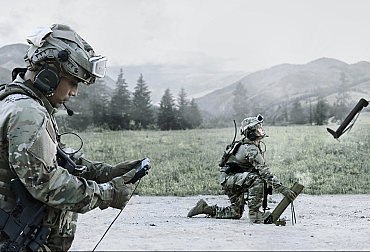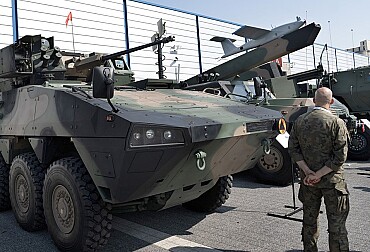What arsenal used Hamas to surprise Israel? Soviet machine guns, paragliders and imported rockets
Thousands fired missiles, thousands deployed terrorists, and a total thousands of casualties on both sides. Coordinated attack by Palestinian Islamists on Israel managed to catch the Jewish state off guard, shocking it with its scale, brutality, and timing. Hamas and its allies used every available means for their unprecedented invasion, from homemade rockets to those imported from abroad, to modified Soviet and Chinese submachine guns and anti-tank weapons. They crossed the heavily guarded Gaza Strip border at multiple points and penetrated Israeli territory by land, sea, and air. All of this, according to foreign experts and even members of Hamas, was under the strict supervision of Iran and training from its specialists.

Israel hadn't experienced such a deployment of jihadists in a generation. The devastating mass attack by Islamist terrorists claimed the lives of 1,400 Israelis, with another two hundred, including women and children, being abducted back to the Gaza Strip. The manner in which Hamas and the Palestinian Islamic Jihad struck the Jewish state shocked the entire world. But how did a group, which has controlled the strictly regulated area since 2007, manage to build a small army capable of surprising one of the most advanced countries in terms of defense? Members of Hamas itself, labeled a terrorist organization by the Czech Republic and fully supporting the positions and actions of the current Israeli government according to recent statements, boast that their current state was achieved through ingenuity. However, in the same breath, they confirm the involvement of a key ally in the fight against Israel - Iran. "Necessity is the mother of invention," Ali Baraka, one of the leaders of Hamas, told Reuters, stating that Tehran provided the financial resources and training. "We have improved our capabilities and can produce our own (rockets). During the 2008 war, they had a maximum range of 40 kilometers, but two years ago it was already 230 kilometers," Baraka added, with a propagandistic tone. Militants fired over two and a half thousand rockets in the recent attack, at times crippling the otherwise very successful and reliable Iron Dome anti-aircraft defense system.
"We also have rockets that are produced locally, but long-range rockets came from abroad, from Iran, Syria, and others through Egypt," confirmed the direct involvement of third countries, especially Iran, in an interview with Al Jazeera by the leader of Hamas, Ismail Haniyeh. He mentioned that last year the group received assistance equivalent to more than one and a half billion Czech koruna. Iran denies involvement in the invasion but approves of it. In addition to training, which according to the behavior and tactics of some Hamas units during the attack included training of special forces members, Iran also directly provides weapons, often old Russian or Soviet-made. "They throw a grenade and immediately take cover. Only someone who has done it before would act that way," says David Benson, an Iraq war veteran and currently an employee of a security firm, in an analysis for CNN. He believes that some of the footage, frequently captured by the Islamists themselves, suggests the involvement of special forces. "Grenades are also expensive, even in the U.S. military," Benson observes, looking at equipment resembling conventional grenades.
Bulldozers, Paragliders, and Drones
The invasion was significantly accelerated in several places by heavy machinery. Not tanks or armored vehicles, which Palestinian radicals did not have or did not have until they raided several Israeli bases, but bulldozers. These bulldozers tore down fences, which the terrorists began to use to penetrate Israeli territory, whether by off-road vehicles, motorcycles, or on foot. They also entered Israel by boat via the sea. Media around the world also noticed a far more bizarre mode of transportation that the Hamas daredevils used, for instance, to ambush and massacre civilians at a music festival - motorized paragliders. "They have relatively limited options. You need the right conditions and environment. There are generally a lot of vulnerabilities," commented Sean Elliott from the regulatory department of the American Association of Experimental Aircraft on the terrorists' surprising tactic for CNN. According to commentators, even these special engines had to be imported into Gaza, likely for this very purpose. However, this was not the first such case. In 1987, an armed Palestinian terrorist flew into Israel using a similar aircraft, killing six soldiers and injuring others before being neutralized.
According to analysts from Calibre Obscura, a research company focused on weapons of the Middle East and North Africa, it's a question of what currently facilitates Hamas's rocket production. They previously used items like plumbing pipes extensively for this purpose. Calibre Obscura noted in several threads on social network X, formerly Twitter, the use of a copy of the Steyr HS .50 sniper rifle, which Iran produces in its unlicensed variant under the name AM-50 Sayyad. In larger numbers, propaganda footage also displayed the use of anti-tank grenade launchers from the USSR, the RPG-7VR.
In the footage from Hamas's invasion, other old Soviet weapons are omnipresent in various modifications, whether it's AK-47 submachine guns or their Chinese variants and newer copies, or the large-caliber DShK machine guns designed for armor-piercing, which the Islamists often mounted directly onto pickups and other vehicles. International experts were also struck by the use of drones, which resembled those recently known from Ukraine. The Palestinians attached small payloads to these smaller unmanned aircraft, dropping them on targets using cameras - in this case, however, based on the released videos, it seems not to kill or create an opportunity to breach the border, but to disable monitoring sensors and prepare the ground for the attack itself. "Drones are the only thing that surprised me. Not so much the fact that they would have them, but that they would be used in such coordinated sophisticated attacks and also considering the videos they released," John Spencer from the Urban Warfare Studies at the West Point Institute of Modern Warfare told CNN.
However, the element of surprise has been exhausted by the militants, and Israel's counteroffensive aimed at the military and political elimination of Hamas will be, and is already starting to be, devastating for the aggressor. Palestinian radicals, despite the mentioned support, lack sufficient resources and fighters. The International Institute for Strategic Studies estimates that Hamas has about twenty thousand members ready to fight, while the Israeli government overestimates this number by another ten thousand. On the side of the Jewish state, there are approximately one hundred seventy thousand members of active units and currently about three hundred sixty thousand called-up reservists, roughly three-quarters of what Israel has available in total. Additionally, Israel has massive foreign support from the West and billions of US dollars in the form of the most modern military technology, which, according to Jerusalem, will never be caught off guard again.










